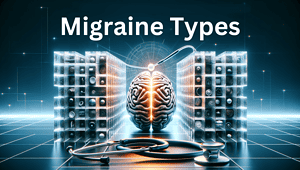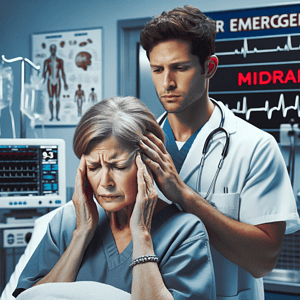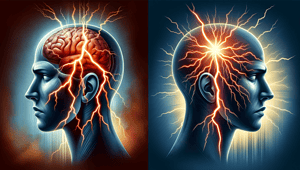Migraines: the mere mention of the word can send shivers down the spine of anyone who’s ever experienced one. Far from being a standard headache, a migraine is a neurological condition that manifests in a variety of crippling ways, impacting millions of lives globally. With 12% of the U.S. population suffering from these merciless head monsters, it’s imperative to understand them better^1^. The first step toward alleviating the pain? Knowing the specific type of migraine you’re grappling with. This detailed guide aims to shed light on the types, symptoms, diagnosis, and treatment options for migraines. Buckle up; it’s going to be an enlightening ride.

The Different Avatars of Migraine
Understanding migraines starts with knowing that they are not a monolithic entity but rather come in various forms, each with its unique characteristics and challenges. Differentiating between these types can be a game-changer when it comes to diagnosis and treatment.
Migraine without Aura
Popularly known as the “common migraine,” this type is the one most people are familiar with. It usually involves a fierce, throbbing pain on one side of the head, often accompanied by nausea and a heightened sensitivity to light and sound. There is no early warning—no “aura”—before the onset of a migraine without aura. This means that the attack can happen suddenly, disrupting your day and making it difficult to find quick relief.
Migraine with Aura
On the flip side, the migraine with aura offers a kind of prelude—a brief show before the main event. The aura manifests as peculiar sensory experiences: flashing lights, blind spots in your vision, or tingling sensations in the face or extremities. These symptoms typically last for about 20 minutes to an hour, giving you a small window to prepare for the impending headache.
Chronic Migraine
Chronic migraine takes the cake for being the most relentless type. If you’re experiencing a headache for 15 or more days per month for more than three months, and at least eight of those headaches are migraines, you’re dealing with chronic migraines. The symptoms closely resemble those of a migraine without aura but occur far more frequently, leading to a significantly impaired quality of life.
Tension-Type Headache (TTH)
Although not a migraine in the strictest sense, tension-type headaches (TTH) are often mistaken for migraines. The pain in TTH is usually less severe and manifests as a constant dull ache around the forehead or back of the head and neck. Unlike migraines, they rarely cause nausea or sensitivity to light and sound.
Symptoms: Beyond the Ache
The symptoms associated with migraines can vary significantly depending on the type. Knowing these symptoms can be crucial for diagnosis and subsequent treatment.
Common Across All Types
Whether it’s a migraine with or without aura or even a chronic migraine, some symptoms are generally common across the board. These include:
- Intense, often throbbing, pain
- Sensitivity to light and sound
- Nausea and vomiting
Migraine without Aura
The sudden onset of pain, usually on one side of the head, is the hallmark of this type of migraine. The pain can last anywhere from four to 72 hours and often gets worse with physical activity.
Migraine with Aura
Before the actual headache sets in, you may experience a range of unusual sensations. These could include visual disturbances like seeing zigzag lines, flashing lights, or even temporary blindness in one eye. In some cases, the aura might manifest as tingling or numbness on one side of the face or body.
Chronic Migraine
The symptoms are similar to those of a migraine without aura but occur with a much higher frequency, often affecting daily functioning and leading to missed days at work or school.
Tension-Type Headache
The pain is usually a constant, dull ache that occurs on both sides of the head. It’s often described as a tight band around the forehead or pressure at the temples or back of the head.
Diagnosis: The Path to Proper Treatment
Proper diagnosis is crucial when it comes to treating migraines effectively. However, this can often be a complex and challenging process due to the overlap in symptoms among the different types of migraines and other headache disorders.
Diagnostic Criteria
Each type of migraine has specific diagnostic criteria:
- Migraine without Aura: Typically diagnosed based on the presence of recurrent headaches lasting 4 to 72 hours, accompanied by other symptoms like nausea, vomiting, and sensitivity to light and sound^3^.
- Migraine with Aura: The diagnosis is usually straightforward if you experience classic aura symptoms like visual disturbances before the onset of the headache^4^.
- Chronic Migraine: A headache must occur on 15 or more days per month for at least three months, and at least eight of those headaches must be migraines for a diagnosis of chronic migraine^5^.
Challenges in Diagnosis
One of the significant challenges in diagnosing migraines is the similarity in symptoms with other types of headaches, particularly tension-type headaches. Additionally, the lack of definitive tests for migraines means that the diagnosis often relies heavily on patient-reported symptoms and medical history.
Treatment: Your Roadmap to Relief
There’s no one-size-fits-all treatment for migraines; each type requires a specific approach.
Acute Treatment Options
These are the treatments you turn to when a migraine attack is already underway.
- Migraine without Aura: Over-the-counter pain relievers like ibuprofen can sometimes be effective. However, specific migraine medications like triptans are often required for moderate to severe attacks.
- Migraine with Aura: Triptans are generally the go-to medication for treating migraines with aura, often providing relief within two hours.
Preventive Treatment Options
These treatments aim to reduce the frequency and severity of migraine attacks.
- Chronic Migraine: For those dealing with chronic migraines, preventive medications like antiepileptic drugs or even Botox injections may be recommended.
Non-Pharmacological Treatments
Don’t underestimate the power of non-drug treatments. Cognitive-behavioral therapy, acupuncture, and even lifestyle and dietary changes can provide significant relief^2^.
Conclusion
Migraines are not just headaches; they’re complex neurological conditions that can severely impact your quality of life. Understanding the type of migraine you’re dealing with is the first step toward effective treatment and ultimately, relief. As research advances, there’s hope that even more effective treatment options will become available in the future^6^.




